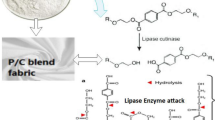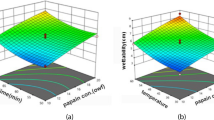Abstract
The aim of this study was to provide the optimum condition for improving the hydrophilicity of PET fabrics by lipase treatment. The lipase hydrolytic activity, moisture regain, and wettability of PET fabrics were measured at different pH, temperature, reaction time, and concentration. The hydrolytic activity of lipase was evaluated by the number of carboxylic groups, using the titration method. Each treatment condition was controlled by measuring the hydrolytic activity, moisture regain, and wettability. The lipase treatment condition was controlled at pH 7.5, temperature 40 °C, treatment time 90 min, and concentration 6.25 g/l. Lipase treatment was an effective method to improve the moisture regain and wettability of PET fabrics because lipase hydrolysis formed hydrophilic groups on the surface of PET fabrics. The surface of the lipase-treated PET fabrics showed cracks and voids, largely responsible for the increase in the PET’s water-related properties. The nitrogen contents of the lipase-treated PET fabrics were measured at only 0.072 %. Thus, the improvement of the surface wettability of the lipase-treated PET surface was associated with the hydrolytic action of lipase rather than with protein absorption.
Similar content being viewed by others
References
H. R. Kim and W. S. Song, Fiber. Polym., 7, 339 (2006).
A. Cavaco-Paulo and G. M. Gübitz, “Textile Processing with Enzymes“, pp.96–191, The Textile Institute, New York, 2003.
O. Kirk, T. V. Borchert, and C. C. Fuglsang, Curr. Opin. Biotech., 13, 345 (2002).
M. C. Thiry, AATCC Review, 1, 14 (2001).
T. Suzuki, Sen-I Gakkaishi, 60, 248 (2004).
M. A. M. E. Vertommen, V. A. Nierstrasz, M. Van der Veer, and M. M. C. G. Warmoeskerken, J. Biotechnol., 120, 376 (2005).
G. M. Guebitz and A. Cavaco-Paulo, Trends Biotechnol., 26, 32 (2007).
E. Chaya and M. Kitano, Sen-I Gakkaishi, 55, 150 (1999).
Y. L. Hsieh and L. A. Cram, Text. Res. J., 68, 311 (1998).
T. Walter, J. Augusta, R. J. Muller, H. Widdecke, and J. Klein, Enzyme Microb. Tech., 17, 21 (1995).
M. Y. Yoon, J. Kellis, and A. J. Poulose, AATCC Review, 2, 33 (2002).
A. K. Chaudhary, E. J. Beckman, and A. J. Russell, ACS Sym. Ser., 684, 18 (1998).
G. Fischer-Colbrie, S. Heumann, S. Liebminger, E. Almansa, A. Cavaco-Paulo, and G. M. Guebitz, Biocatal. Biotransfor., 22, 341 (2004).
M. Alisch-Mark, A. Herrmann, and W. Zimmermann, Biotechnol. Lett., 28, 681 (2006).
F. Hasan, A. A. Shah, and A. Hameed, Enzyme Microb. Tech., 39, 235 (2006).
K. Bagi, L. M. Simon, and B. Szajáni, Enzyme Microb. Tech., 20, 531 (1997).
G. Bassani, B. Farruggia, B. Herli, D. Romanini, and G. Picó, J. Chromatogr. B, 859, 222 (2007).
A. Houde, A. Kademi, and D. Leblanc, Appl. Biochem. Biotech., 118, 155 (2004).
R. Levene, JSDC, 113, 206 (1997).
Novo Nordisk A/S, U.S. Patent, 5997584 (1999).
S. H. Lee and W. S. Song, J. Korean Soc. Clothing Text., 22, 1032 (1998).
“Sigma Quality Control Test Procedure“, http://www.sigmaaldrich.com/sigma/enzyme%20assay/l3126enz.pdf, 11 Nov., 2006.
“Determination of Lipolytic Activity of Lipase for Industrial Use“, Japanese Standard JIS K 0601, 1995.
Author information
Authors and Affiliations
Corresponding author
Rights and permissions
About this article
Cite this article
Kim, H.R., Song, W.S. Optimization of enzymatic treatment of polyester fabrics by lipase from Porcine Pancreas . Fibers Polym 9, 423–430 (2008). https://doi.org/10.1007/s12221-008-0068-3
Received:
Revised:
Accepted:
Published:
Issue Date:
DOI: https://doi.org/10.1007/s12221-008-0068-3




